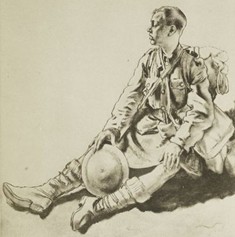 Last night, Microkhan finally got around to completing the Stanley Kubrick circuit by watching Paths of Glory. Suffice to say that the film is a potent reminder of the World War I’s absolute ghastliness; we can scarcely imagine what it must have been like to be an 18-year-old lad in the trenches, ordered to venture into No Man’s Land where certain (and totally pointless) death awaited. Talk about a low point for humanity…
Last night, Microkhan finally got around to completing the Stanley Kubrick circuit by watching Paths of Glory. Suffice to say that the film is a potent reminder of the World War I’s absolute ghastliness; we can scarcely imagine what it must have been like to be an 18-year-old lad in the trenches, ordered to venture into No Man’s Land where certain (and totally pointless) death awaited. Talk about a low point for humanity…
One scene, in particular, sticks in our minds. Toward the very beginning, a French general encounters an enlisted man who’s clearly a psychological casualty. Upon being informed of this fact by an underling, the general rages that shell shock is nothing but a myth—in fact, the prevailing view among the military elite at that time. An untold number of soldiers were thus shot for cowardice, rather than given the medical attention they so desperately required.
As the war dragged on, however, even the most recalcitrant of generals came to acknowledge that there were psychological consequences to surviving bombardment after bombardment. And so the shell shocked were subjected to a particularly unpleasant form of treatment: Torpillage:
One of the most common treatment modalities, particularly popular in the French Army, was a form of faradization (application of electric shock, using very high voltage and low amperage) called torpillage. It was found to be particularly useful when shocks were applied to the affected part of the body. Very high levels of success were reported; contracture rapidly disappeared, and/or vision, speech, hearing, use of a limb, etc. were rapidly restored. The use of “electric therapy” to “restore proper function to weak nervous systems” and “weak nerves” went back for a good number of years.
The British, by contrast, were more apt to use “pep talks and appeals to patriotism and loyalty.” Probably just as effective as torpillage, but a great deal less sadistic.
Chilling vids of shell shockees here and here. Thank your lucky stars you weren’t a European male of military age circa 1915.


Jordan // May 11, 2009 at 12:14 pm
Sadly it’s taken until more recent times for the American military to even begin addressing the scope of psychological issues that service members face. What was done (or more precisely not done) after Vietnam was almost as much of a tragedy as what was done in the war. Thankfully now the Army especially seems to be putting some emphasis on preparing soldiers psychologically for what they are going to face, acknowledging that there will be mental and emotional conflicts that result from combat and helping them to face and deal with the fallout. Despite thousands of years of conflict, most human beings are really set up to deal with killing each other. And I’d like to think that we’re better off that way.
Brendan I. Koerner // May 11, 2009 at 4:21 pm
@Jordan: The question that I’ve always had is whether ancient soldiers suffered combat stress reaction, too. Is there any evidence that, say, members of the Roman Legions suffered forms of “madness” (for lack of a better term) due to their exposure to inordinate amounts of bloodshed? Or is there something about the Age of Gunpowder that has altered the psychological equation?
On a tangent, what do you think of the whole debate over whether or not to award Purple Hearts to soldiers afflicted with PTSD? I never quite made my mind up about that one.
“My War-Weary Willie…” // May 19, 2009 at 11:01 am
[…] depressingly familiar, […]
“Take Up the Sword of Justice” // Sep 3, 2009 at 10:29 am
[…] All of the material is not only an educational time suck; it’s also a reminder of how thankful we are not to have been, say, an 18-year-old British male in 1914. Those were some dark times. […]
When the Disease Beats the Cure, Part II // Jan 12, 2010 at 2:58 pm
[…] to increase a patient’s misery. Several months back, for example, we wrote about the use of Torpillage to treat victims of shell shock. Now, via the journals of the great Irish explorer John Palliser, […]